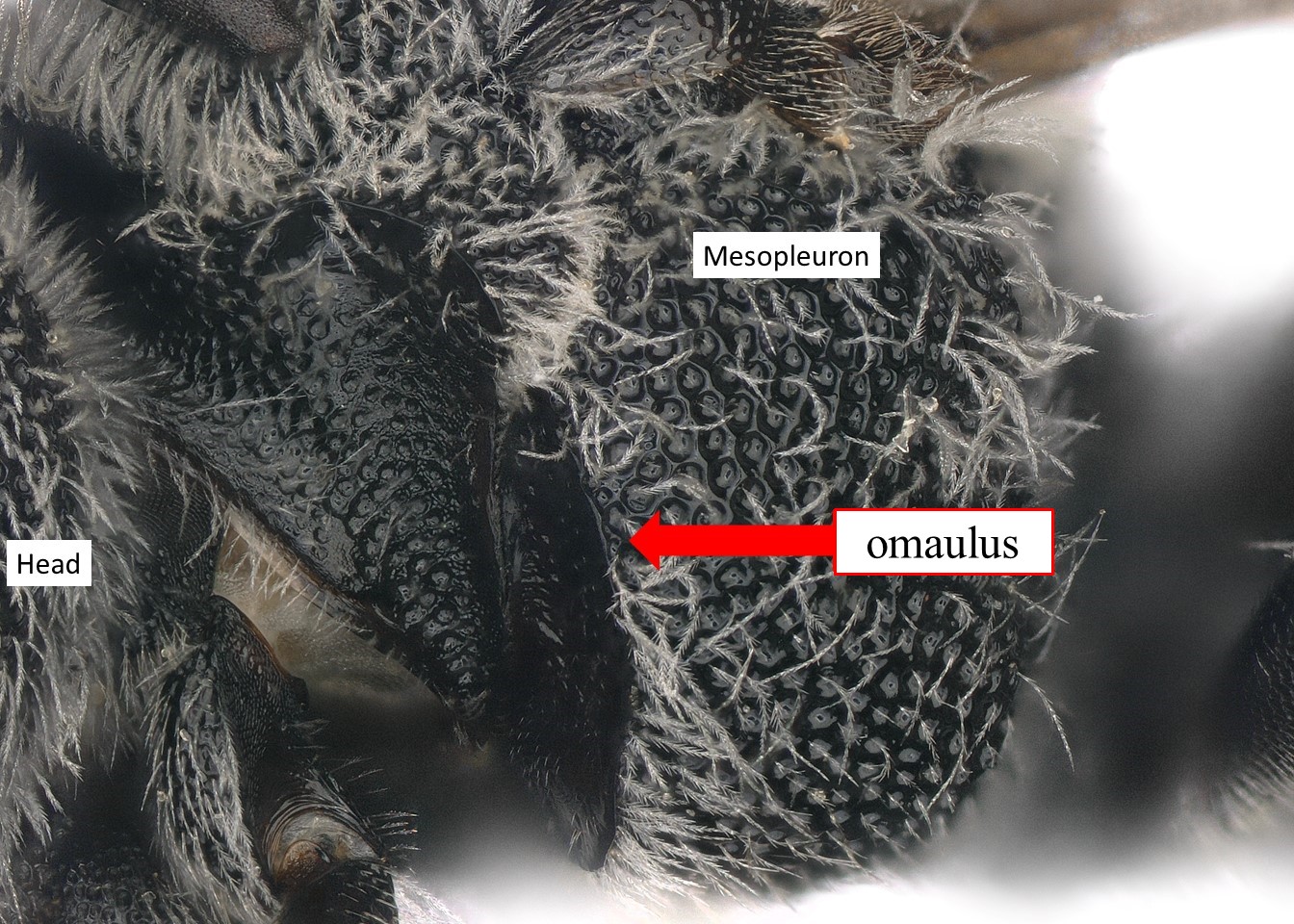Family: Megachilidae
Subfamily: Megachilinae
Tribe: Anthidiini
Genus: Euaspis Gerstäcker, 1857
Subgenera: none
Common name: none
Euaspis are cleptoparasiticcleptoparasitic:
bees that lay their eggs in the nest cells of bees in other genera. Their larvae depend on the pollen provided by their host. Since cleptoparasitic bees don't provision their own nests, and instead depend on the pollen collected by their host, the females lack pollen collecting hairs. This often gives them a wasp-like appearance.
bees with a black head and thorax, and red abdomen that lacks yellow maculations. They range in body length from 6–17 mm (Michener 2007Michener 2007:
Michener, C.D. 2007. The Bees of the World (2nd ed.). Johns Hopkins University Press, Baltimore and London, 953 pp.).
Euaspis contains 12 described species, and there are no subgenera (Baker 1995Baker 1995:
Baker, D.B. 1995. A review of the Asian species of the genus Euaspis Gerstauml;cker (Hymenoptera: Apoidea: Megachilidae). Zoologische Mededelingen, 69: 281ndash;302.; Pasteels 1980Pasteels 1980:
Pasteels, J.J. 1980. Revision du genre Euaspis Gerstauml;cker (Hymenoptera: Apoidea: Megachilidae). Bulletin amp; Annales de la Socieacute;teacute; Royale Belge d#39;Entomologie 116: 73ndash;89.); none are known to occur in the U.S. or Canada.
(modified from Michener 2007Michener 2007:
Michener, C.D. 2007. The Bees of the World (2nd ed.). Johns Hopkins University Press, Baltimore and London, 953 pp.)
 carinatecarinate:
carinatecarinate: tridentate or trilobed.
tridentate or trilobed.Euaspis can resemble some species of Pachyanthidium, which may also have a black head and thorax and red abdomen, as well as a similar flat and produced scutellumscutellum:
shield shaped plate behind scutum (Michener 2007Michener 2007:
Michener, C.D. 2007. The Bees of the World (2nd ed.). Johns Hopkins University Press, Baltimore and London, 953 pp.). Euaspis can be readily distinguished by the presence of juxtantennal carinacarina:
a clearly defined ridge or keel, not necessarily high or acute; usually appears on bees as simply a raised line
and a raised median ridge from the fronsfrons:
the area between the antennae and ocelli on the bee's head to the supraclypeal areasupraclypeal area:
the region of the head between the antennal sockets and clypeus, demarcated on the sides by the subantennal sutures (Michener 2007Michener 2007:
Michener, C.D. 2007. The Bees of the World (2nd ed.). Johns Hopkins University Press, Baltimore and London, 953 pp.).
There are no known invasives.
Euaspis nesting behavior is unique when compared to other cleptoparasiticcleptoparasitic:
bees that lay their eggs in the nest cells of bees in other genera. Their larvae depend on the pollen provided by their host. Since cleptoparasitic bees don't provision their own nests, and instead depend on the pollen collected by their host, the females lack pollen collecting hairs. This often gives them a wasp-like appearance.
bees, in that the adult removes the existing egg or larvaelarvae:
active immature form of an insect, especially one that differs greatly from the adult and forms the stage between egg and pupa
from their host’s nest instead of the cleptoparasiticcleptoparasitic:
bees that lay their eggs in the nest cells of bees in other genera. Their larvae depend on the pollen provided by their host. Since cleptoparasitic bees don't provision their own nests, and instead depend on the pollen collected by their host, the females lack pollen collecting hairs. This often gives them a wasp-like appearance.
larvae killing the host. Euaspis have been known to wait until their host builds its nest, lays its eggs, and closes its nest cells. Euaspis then bores into the closed cell and throws out any of the host’s larvaelarvae:
active immature form of an insect, especially one that differs greatly from the adult and forms the stage between egg and pupa
living in the cell. It is believed Euaspis eat any eggs found in the nest since eggs are not thrown out of the nest. The Euaspis adult then gathers any scattered pollen together in each cell and lays her egg on the pollen mass. She then closes the hole bored in the cell with resin or pollen (Iwata 1976Iwata 1976:
Iwata, K. 1976. Evolution of Instinct: Comparative Ethology of Hymenoptera. Amerind Publishing Co. Pvt. Ltd., New Delhi, 536 pp.).
Euaspis is widespread in sub-Saharan Africa, and from Pakistan to eastern and southeastern Asia. Of the 12 species, 2 are from Africa, and 10 are from Asia (Michener 2007Michener 2007:
Michener, C.D. 2007. The Bees of the World (2nd ed.). Johns Hopkins University Press, Baltimore and London, 953 pp.).
Distribution map generated by Discover Life -- click on map for details, credits, and terms of use.
Baker, D.B. 1995. A review of the Asian species of the genus Euaspis Gerstäcker (Hymenoptera: Apoidea: Megachilidae). Zoologische Mededelingen, 69: 281-302.
Iwata, K. 1976. Evolution of Instinct: Comparative Ethology of Hymenoptera. Amerind Publishing Co. Pvt. Ltd., New Delhi, 536 pp.
Michener, C.D. 2007. The Bees of the World (2nd ed.). Johns Hopkins University Press, Baltimore and London, 953 pp.
Pasteels, J.J. 1980. Revision du genre Euaspis Gerstäcker (Hymenoptera: Apoidea: Megachilidae). Bulletin & Annales de la Société Royale Belge d'Entomologie 116: 73-89.